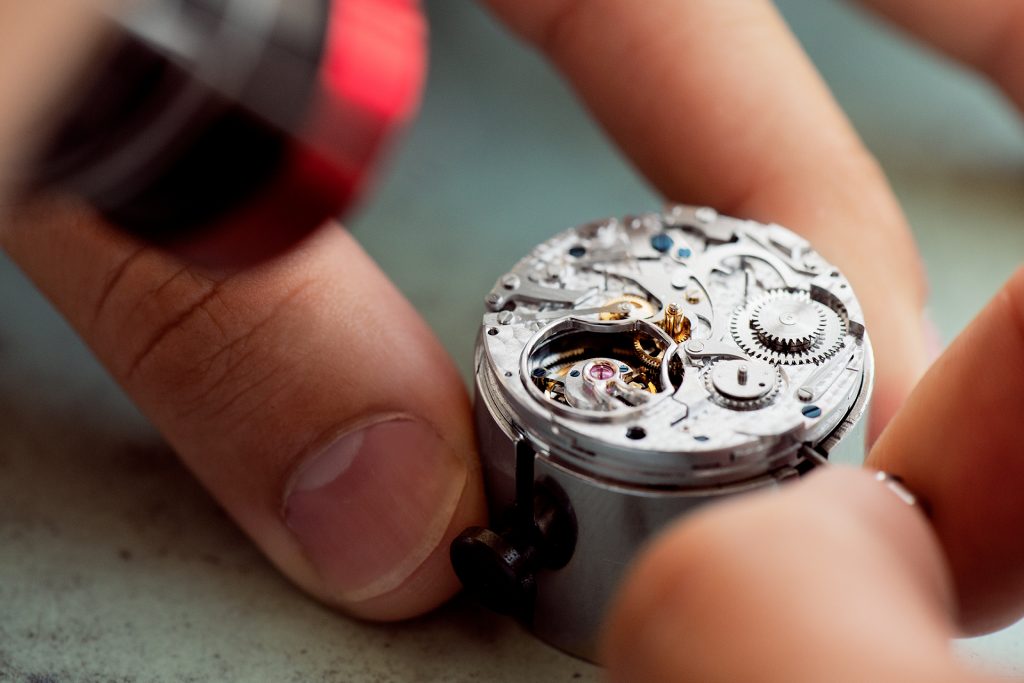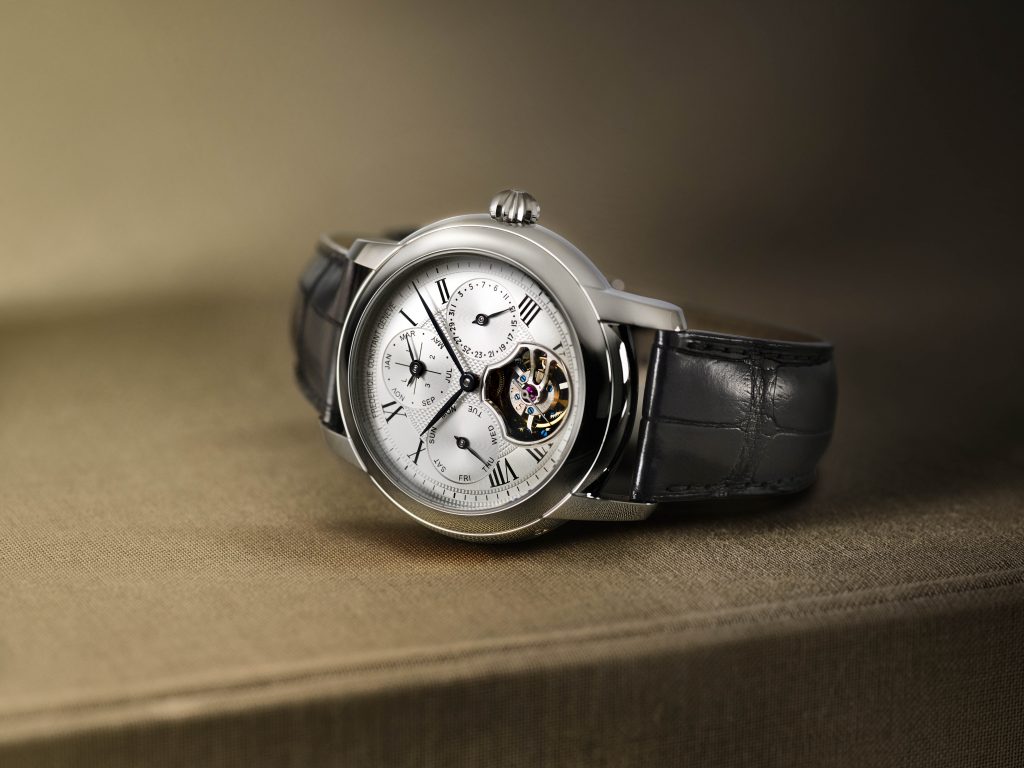
Frederique Constant Perpetual Calendar Tourbillon in honor of the brand’s 30th anniversary. This watch is crafted in steel with a dial and just 88 pieces will be made.
Last night in Paris, Frederique Constant celebrated its 30th anniversary in a big way, and unveiled new QP Tourbillon Manufacture watches to honor the three-decade milestone. I will bring you more details of the event and of the momentous, anniversary, as well as hands-on photos of the watches when I return from Paris, but for now, I bring you a quick look at the four watches that comprise the QP Tourbillon special editions — one of which is crafted in solid 18-karat gold and made in a lot of just 30 pieces to celebrate the 30th anniversary.
With a tag line of Live Your Passion, Frederique Constant has made great strides in Swiss watchmaking since the husband/wife team of Peter and Aletta Stas first started creating Swiss watches in 1988.Their goal was always to create high-quality watchmaking at affordable quality-for-value pricing. It was just a few years later that they founded Frederique Constant SA, and began to build what is today one of the best-known affordable quality Swiss watch brands. In fact, over the years, the brand has built an incredible collection of more than 27 different in-house movements and sophisticated timepieces boasting useful functions for today’s active lifestyles. Now, to honor the 30th anniversary, Frederique Constant (purchased in 2016 by the Citizen Group) unveils four new QP Tourbillon watches whose looks and prices will knock you over.
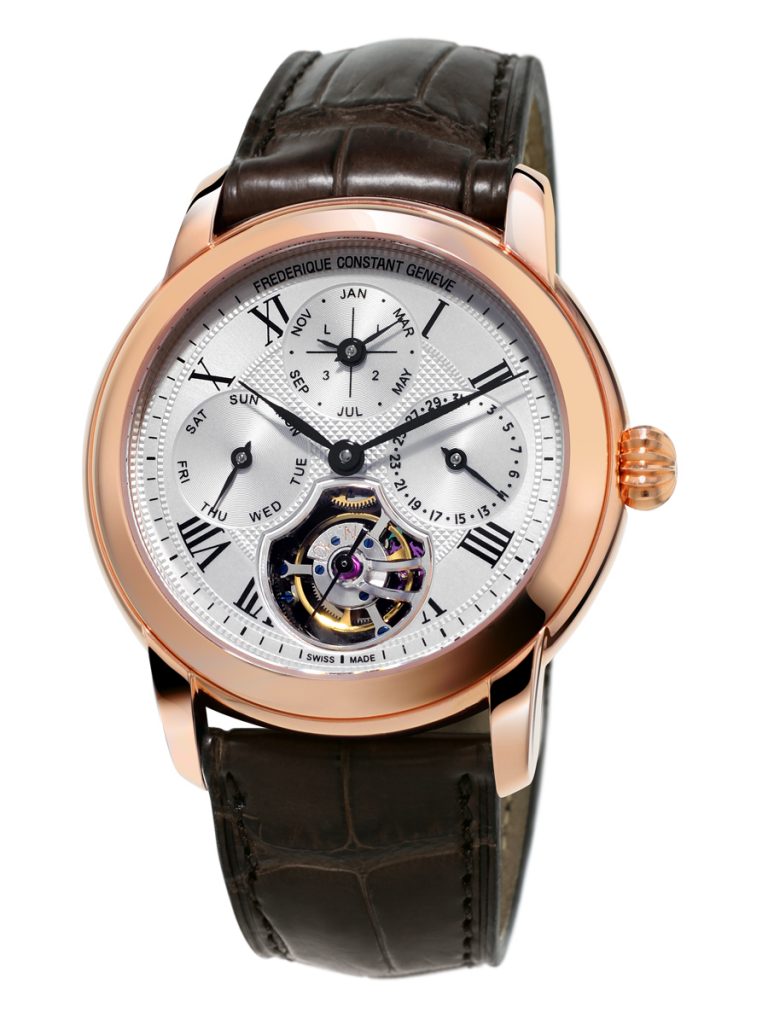
Frederique Constant Perpetual Calendar Tourbillon in honor of the brand’s 30th anniversary. This version with dial is crafted in rose-gold-plated steel.
The star piece in the new QP Tourbillon release is an 18-karat rose gold 42m model with open-worked dial, being built in an edition of 30 pieces only. There are three other versions of the QP Tourbillon in addition to the rose gold model and 88 of each of those will be made. Each is a 42mm case size and each houses the same new movement: the automatic FC-975 Manufacture caliber with Tourbillon and perpetual calendar. The watches are offered in stainless steel, or in rose-gold-plated stainless steel, with finely worked dial or with open-worked dial.
However, before I describe the watches, I must first deliver the sticker shock information: these Swiss-made complicated timepieces, made in limited editions, retail starting at an incredible $19,995 and ranging to $22,995. Even the solid gold version retails for just $32,995. There. The cat is out of the bag. Thanks to the amazing vertical integration of the Frederique Constant brand, and thanks to the founders always remaining true to their creed of affordable luxury, one can now obtain a truly sophisticated watch at a truly manageable price.
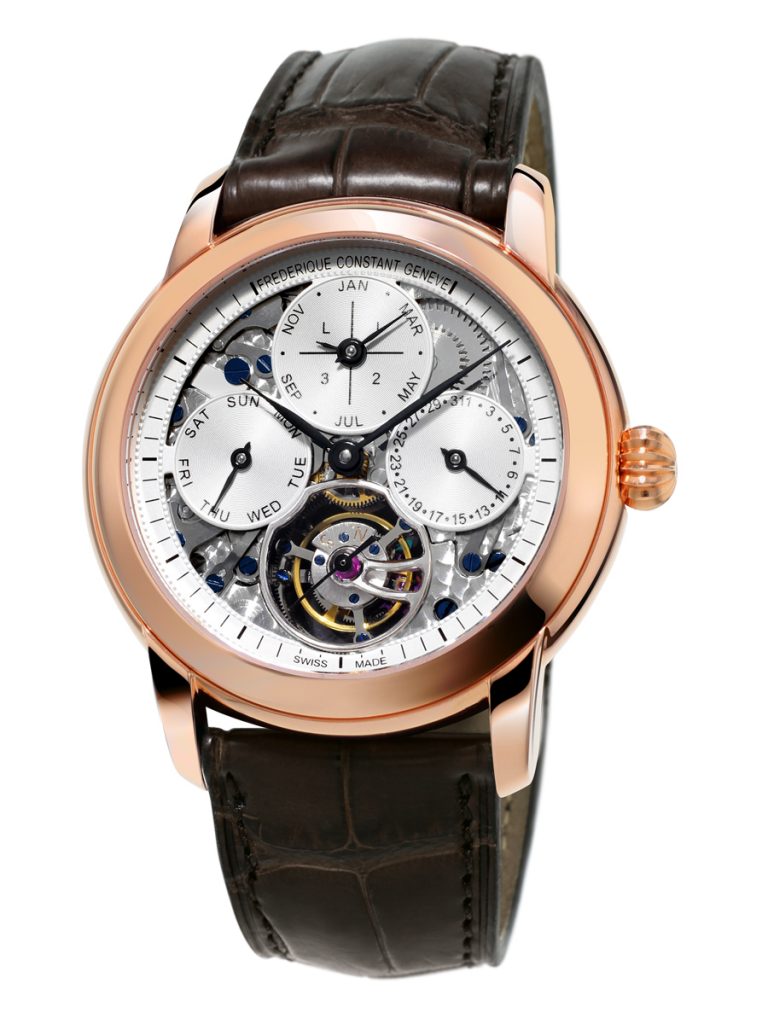
Frederique Constant Perpetual Calendar Tourbillon in honor of the brand’s 30th anniversary. This is the solid 18-karat gold version with skeletonized dial. $32,995.
Now to the Frederique Constant Perpetual Calendar Tourbillon Watches
As mentioned, the piece d’ resistance is the 18-karat gold Frederique Constant Perpetual Calendar Tourbillon Manufacture in a limited series of 30 pieces, Developed in-house in its manufacture workshops in Plan-les-Ouates, Switzerland. The watch is a deft evolution of several technically advanced timepieces the brand created in the past, including its first patented in-house HeartBeat Manufacture caliber (2004), its first in-house manufacture Tourbillon based on the Heart Beat Manufacture (2008), and its first in-house Perpetual Calendar (2016). So it makes grand sense that for its 30th anniversary, the brand combine these masterpieces into a special grand complication.
The new caliber, FC-975 not only features a tourbillon escapement to compensate for errors in timekeeping due to the effects of gravity when the watch is in certain positions on the wrist, but also offers a perpetual calendar that taks into account day, date, months, years and even leap year. The new movement conduits of 188 pieces, 80 of which comprise the tourbillon cage. The caliber houses a silicium escapement wheel and anchor, and a smart weight balance wheel. These all offer lighter weight, more durability, anti-magnetic qualities, reduced friction and reduced need for servicing. The Tourbillon has been developed in an industrialized process to the last exacting detail, enabling smart pricing.
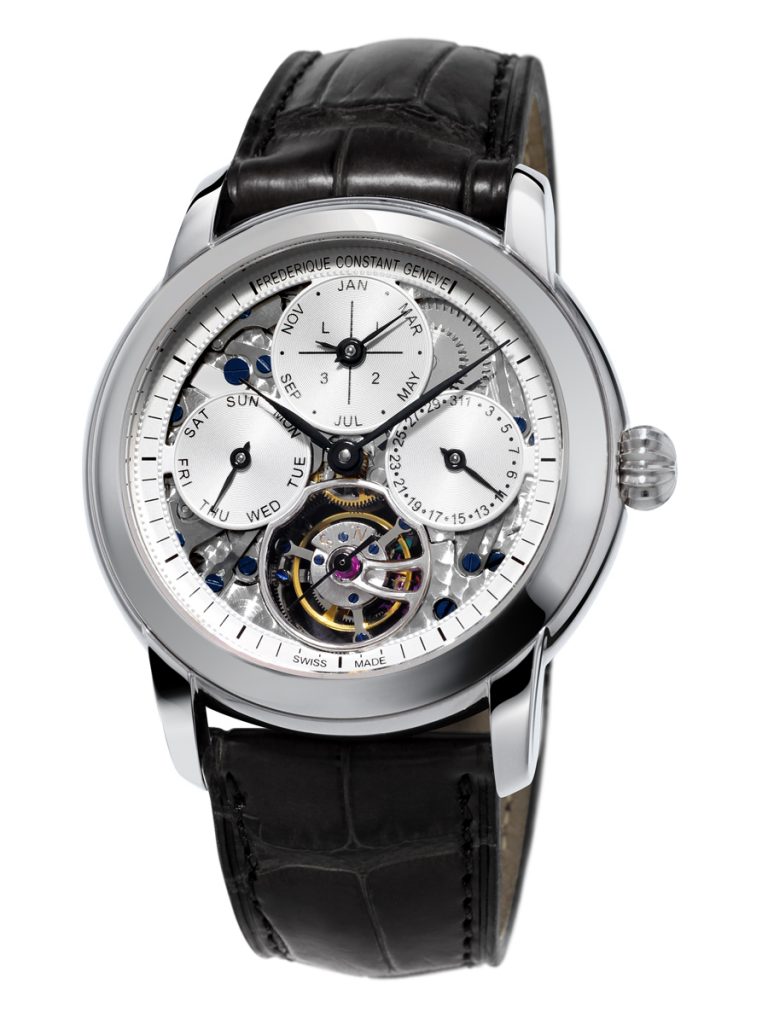
Frederique Constant Perpetual Calendar Tourbillon in honor of the brand’s 30th anniversary. This stainless steel version with skeleton dial is offered in a limited, numbered edition of 88 pieces.
Frederique Constant Perpetual Calendar Tourbillon Details
Frederique Constant patented the perfectly balanced cage, which is composed of 80 components all produced with a precision of 1-2 micron (0.001-0.002 mm) by the CNC machines in the Manufacture’s ateliers. The watch beats at 4 Hertz and has a power reserve of 38 hours. The perpetual calendar requires no adjustment until March 1, 2100, when we skip a scheduled leap year to sync real time and calendar time. The tourbillon cage at 6:00 on the dial, also incorporates a seconds hand indicator and so it rotates once per minute.
In addition to the 18-karat rose gold version made in a limited and numbered edition of 30 pieces, there are three other versions, all featuring a three-part 42mm case and housing the same movement. It is just the case material and dials that vary. Two of the timepieces display a skeleton silver color dial with printed roman numerals and a beautiful view of the perlage hand-decorated components. The skeletonized dial versions feature sapphire case backs, as well, to allow for viewing of the delicate Côtes de Genève decoration. The other two versions display a very clean and refined silver colored dial, with Clous de Paris guilloché decorations and printed Roman numerals. These versions are offered either in stainless steel, or in 18-karat rose-gold-plated steel, and are finished with alligator straps.
Frederique Constant’s 30 Year History
For those interested in the journey of Frederique Constant, founded by Peter and Aletta Stas, please read their formal history below.
Peter C. Stas and Aletta Stas-Bax developed an initial idea, whose time would come in 1988, as the result of something they noticed while on a ski vacation in the Swiss Alps. They saw a wristwatch in a shop window that they couldn’t forget. “Their intellectual discussion about this model rapidly grew into a full-blown passion for timepieces worn on the wrist. It reached the point where the couple had no choice but to sacrifice their promising careers in multinational companies on the altar of their own watch business. Rome was not built in a day, and similarly, their journey to chronometrical entrepreneurship was not completed overnight. In the mid-nineteen eighties, the couple went to Hong Kong in the course of their work. As watches were naturally having a moment over there too, Peter Stas set up a small company selling high-quality design software, in parallel with his day-to-day occupation. The ambitious owner also used this company to design his first wristwatches. Because he considered what was produced in China as anything but attractive, he pored over books and relevant catalogs. From this grew the first succession of prototypes, produced from different components on the kitchen table at home. Aletta Stas exhibited some of these at the watch fair in Hong Kong. Initially they fell flat. But shortly before the end of the fair, a Japanese wholesaler placed an order for 350 watches. These sold with amazing speed. Orders for a further 1,100 watches gave the necessary encouragement for a small prototype collection of just six models altogether. The elegant cases contained electronic quartz movements alone. Because quality then played a vital role, assembly was carried out in Switzerland, using Swiss Made parts. These babies also thrived splendidly. But logic demanded that they should also have a suitable name. In this situation, Frederique Schreiner, Aletta’s great-grandmother, and Constant Stas, Peter’s great-grandfather, entered the scene. The first names of these two ancestors were combined to make Frederique Constant.

The Frederique Constant Perpetual Calendar Tourbillon features a silicon escapement and high-tech parts.
In 1992, Frederique Constant SA, founded with a capital of 60,000 Swiss francs, had over a thousand Swiss Made wristwatches produced by external partners. Brisk sales gave the motivation for greater deeds. At this point, a meeting with a man named Miguel Garcia proved to be a real stroke of luck. This former sales manager, now owner of the “Ebauche” specialists Sellita, expressed an interest in the suggestion of opening up the front of the Eta 2836 automatic movement, relatively high in build. In this way, the tick of a mechanical watch, which Robert Levine had described as “the heart-beat of human culture”, was made vividly visible. The highly successful “Heart Beat” collection was launched in 1994. Because the young entrepreneurs had not thought of legal protection, their creation was swiftly copied by numerous imitators. A second resource in the form of private label production, subsequently abandoned, made it possible at the time to produce larger quantities and thus reduce costs. A first business plan for a Geneva head office submitted in 1996 was accompanied by an application for a Swiss work permit. The authorities granted it on condition that he employed at least twelve persons within five years. The move to Switzerland took place the same year. The workshop, understandably still a small one, was located in a picturesque area of Geneva, Carouge. This step and the continuous growth that followed it were financed entirely from internal resources. This guiding principle remained unaltered throughout the subsequent years. Outside capital in the house of Frederique Constant was always kept within very narrow limits, which was highly beneficial to entrepreneurial freedom in the very much larger premises in the Geneva neighborhood of Chêne-Bourg, purchased in 2000. In 2001, a clear vision and the urge to set something personal beside the bought-in watch movements gave the starting signal for the development of the first in-house Manufacture caliber. This ambitious project was successfully achieved with the cooperation of specialists from two watchmaking schools, one in Geneva and the other in Holland. It was in 2004 that the ambitious family firm astonished the watchmaking world with its FC-910-1. The hand-wound movement featured a prominent aperture in the dial at 6 o’clock in which the strikingly large balance wheel was reminiscent of a tourbillon. The 2005 moon-phase version FC-915 was followed in 2006 by an exclusive automatic model called the FC 930.
In 2007, Frederique Constant became a talking point, not only through the first “Passion Award” in honor of outstanding entrepreneurial performance, but also through its partnerships with Croatian singer Nina Badric, Chinese actress Shu Qi and the legendary English sports-car brand Austin Healey. The year 2010 saw, among other events, Passion Awards in New York, a “Par Cœur Gala” with American actress Eva Longoria and sponsorship of the spell-binding Oldtimer Rally from Beijing to Paris. In the same year, limited editions highlighted the partnership with Cohiba, as did the 2013 collaboration with the Riva Historical Society and Spanish model Inés Sastre. To mark the 25th anniversary of the company’s foundation, Aletta and Peter Stas also published a superb, large volume book entitled “Live Your Passion”. In abundant detail, it relates the thrilling success story of Frederique Constant and also of its two affiliated watch brands, Alpina and Atelier de Monaco.
And most recently, in 2016 the firm succeeded in signing up American actress Gwyneth Paltrow as its official Charity international ambassadress. There have been several outstanding watchmaking achievements: In a limited edition of 188 pieces, the “Heart Beat Tourbillon“, developed and produced entirely in-house, made its debut in 2008. Its special features consisted of a “smart screw” system to ensure the perfect balance of the cage, a silicon escape wheel and, an absolute matter of course in the eyes of Pim Koeslag, the chief engineer, a stop device, not specifically mentioned, for setting the time to the precise second. In 2008, twenty years on from his modest beginnings in faraway Hong Kong, Peter Stas was able to announce an output of 90,000 watches within one year. Furthermore, and not least, the increased value creation from the in-house Manufacture had doubled sales within a period of only a few years. Of course, as the economics graduate with a strong taste for innovation was the first to admit, the watches with in-house movements only occupied a niche market in comparison with total production. The philosophy of delighting an international circle of customers with accessible luxury was founded primarily on elegant timepieces with bought-in electronic or lovingly refined mechanical movements.
In the Manufacture, inaugurated in 2006 and once again financed as far as possible by internal resources and with the head office being extended at that time due to non- stop growth, over 80 per cent of the components needed for the House’s own movements were produced. In 2018, the year of the company’s 30th anniversary, the product range already comprised 27 calibers, grouped in two families. All those beginning with the figure 9 display the escapement in full view from the front. In contrast, the “Maxime”, Manufacture caliber FC-7xx, launched in 2009 and equipped exclusively with automatic winding, does not reveal its heartbeat. The basic caliber FC- 710 with central seconds, and proven reliability, is 30 mm in diameter and 6.2 mm thick. Its rotor winds the mainspring in both directions. When fully wound, the power reserve can keep the balance wheel oscillating at a frequency of 4 Hz for 42 hours. The watchmakers need 137 components for each one of these movements.
After the tourbillon, Frederique Constant waited until 2016 before introducing a further horological complication. The 78-component calendar mechanism of the exclusive FC- 775 automatic caliber, provided the watch is wound regularly, will remain accurate until the year 2100, when it will require a small manual correction. The price of this mechanical masterpiece is sensational. Combined with a tourbillon, this led, in 2018, to an outstanding wristwatch launched exactly on the firm’s birthday with the new FC- 975 automatic caliber, which fully merits the designation “Grande Complication”. 88 of these timepieces are available in three different versions, in pure stainless steel or with pink gold coating. Once again, the price-performance ratio is extraordinary by any standard.
Combined with a tourbillon, this led, in 2018, to an outstanding wristwatch launched exactly on the firm’s birthday with the new FC-975 automatic caliber, which fully merits the designation “Grande Complication”. 88 of these timepieces are available in three different versions, in pure stainless steel or with pink gold coating. As a stunning highlight, Frederique Constant also offers just 30 exclusive edition timepieces featuring a solid pink gold case. In each of these cases, the price-performance ratio is extraordinary by any standard.
To Aletta and Peter Stas who, in the absence of a family successor, sold their company to the Japanese Citizen Group in 2016, “accessible luxury” is more than just a slogan. This theme is ever-present in the company’s history, relatively brief but extremely intense, as it is in the Chronograph, impressively equipped with the Manufacture automatic caliber FC-760, which was launched in 2017. In three decades, Frederique Constant has succeeded in democratizing time measurement with the aid of refined wristwatches of invariably outstanding elegance.
In the end, the firm has also broken new ground in the much-disputed and controversial field of the smart wristwatch. Presented in several generations at once in 2015, the “Horological Smartwatch”, with analogue time and function display, also achieved a world premiere in 2018. “Hybrid manufacture”, as its name implies, unites the best of two apparently incompatible worlds, thus signposting a path to get back to the future. While the Manufacture automatic FC-710 provides the display of precious time, an electronic module mounted on the front is responsible for the panoply of smart functions. And incidentally, it monitors the ticking mechanism and brings its accuracy to be displayed on the screen of a smartphone. This wristwatch of Federal provenance, which can be linked to Android and iOS telephones, testifies to the uninterrupted creativity the firm devotes to the service of a demanding clientele.
No wonder Frederique Constant continues to pursue its growth course unswervingly. By the end of the anniversary year of 2018, around 160,000 wristwatches will be produced.”


